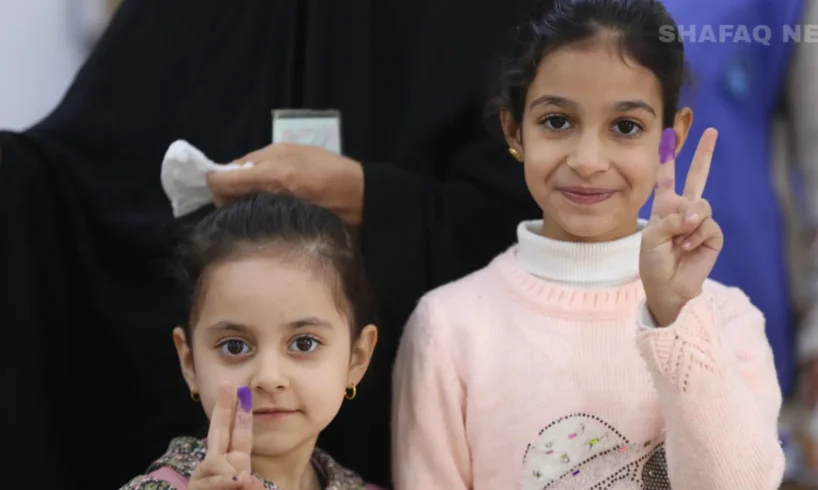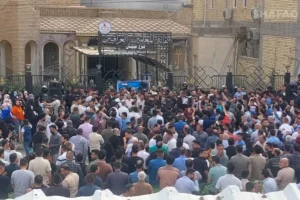
Shafaq News
Iraq’s sixth
parliamentary elections — held through special and general voting on November 9
and 11 with a turnout of 56.11% — revived an old argument about how the
country’s electoral rules are drawn, and who they ultimately serve.
The 2025 vote was the
first major test of the amended Election Law No. 9 of 2020, reinstated in March
2023, and its impact was felt immediately across the political map.
The amended Law
restored each province as a single electoral district and brought back a
modified Sainte-Laguë formula with a first divisor of 1.7. The shift
effectively reversed the 2021 model inspired by the 2019 Tishreen protest
movement, which had divided provinces into dozens of smaller constituencies and
opened a door — briefly — for independents, protest-linked groups, and smaller
alliances to break into parliament. By raising the threshold and reintroducing
large districts, the 2023 changes once again tilted the playing field in favor
of long-established parties with stronger networks and deeper funding.
Read more: Iraq’s 2025 Elections: Voter turnout formula sparks controversy
A Divisor That
Redraws Power
Under the system used
in November 2025, each list’s votes are divided by sequential odd numbers
starting at 1.7, then 3, 5, 7, and so on. The first divisor is the most
decisive: at 1.7, it raises the number of votes required to secure a list’s
initial seat, giving major blocs an early advantage and tightening the entry
point for newcomers.
The 329 parliamentary
seats are allocated first to lists based on these calculations, then awarded to
the highest-voted candidates within each list.
In global practice,
Sainte-Laguë usually begins at 1.1 — a far more accessible threshold for
smaller parties. Iraq has previously used divisors as high as 1.9, and the
return to 1.7 reignited concerns that electoral engineering remains a political
tool.
The Law also
maintains a 25% quota for women and reserves nine seats for minority
communities. These nationwide minority districts often attract heavy
campaigning from larger sectarian parties, giving them indirect influence over
communities with smaller populations and lower turnout.
Read more: 20 Years of voting patterns: Why Iraqis continue to elevate the sitting Prime Minister’s list
Undoing the 2021
Experiment
While the amended Law
mirrors the approach used in 2018, it marks a major departure from the 2021
elections, which divided Iraq into 83 micro-districts. Smaller districts meant
lower entry barriers — allowing candidates with strong local support, even
without party machinery, to win seats.
Combined with a first
divisor of 1.0, the 2021 system produced one of Iraq’s most diverse parliaments
since 2003. It rewarded independents, Tishreen-linked actors, and local
reformist groups.
When the Law Changes,
the Map Changes
In 2018, the newly
formed Sairoun list (Sadrists), backed by Muqtada Al-Sadr, led the results with
54 seats, followed by the Fatah Alliance under Hadi Al-Amiri with 48. Nouri Al-Maliki’s
State of Law secured 25 seats.
Sunni factions,
including Iyad Allawi’s Al-Wataniyah, won 21, while Kurdish parties held
steady: the Kurdistan Democratic Party (KDP) with 25 seats and the Patriotic
Union of Kurdistan (PUK) with 18.
But the 2021
elections — held under smaller districts and a 1.0 Sainte-Laguë divisor —
produced a dramatically different landscape. The Patriotic Shiite Movement
(Sadrists/Sairoun) jumped to 73 seats, the Fatah Alliance collapsed to 17, and
Al-Maliki climbed to 31. Mohammad Al-Halbousi’s new party, Taqaddum, surged to
37 seats.
Kurdish
representation remained broadly stable. Reformist groups such as Emtidad and
New Generation (Al-Jeel Al-Jadeed) captured nine seats each, and 40
independents made it into parliament.
Most of that shifted
again in 2025.
With Iraq reverting
to a system similar to 2018, the major alliances regained ground:
-Reconstruction and
Development (Al-Ima’ar wal-Tanmiya), led by Prime Minister Mohammed Shia Al-Sudani,
won 46 seats (the alliance includes several political parties).
-State of Law secured
29.
-Taqaddum won 27.
-Badr — a core party
within the Fatah Alliance — won 21 seats.
Kurdish parties also
maintained almost the same overall share of seats. Meanwhile, Ishraqat Kanoun
was one of the few exceptions, rising from six seats in 2021 to ten in 2025.
“Built for the Big
Blocs”
Legal expert Mohammed
Jumaa told Shafaq News the amended Law was “designed from the outset for the
major blocs,” adding that when the starting divisor exceeds 1.5, the system
“overwhelmingly favors” large alliances.
“At 1.7, it becomes
nearly impossible for small lists to win at all,” he said, noting how powerful
parties pushed to undo the 2021 district system.
Independent
politician Athir Al-Shar’a described the framework as “a form of disguised
authoritarianism,” arguing that major parties leveraged their financial,
organizational, and media capacity to secure their advantage and limit new
entrants. He said that a cleaner version of Sainte-Laguë — used within multiple
districts — could have offered fairer chances. Instead, “administrative
barriers” and “politically engineered districts” blocked civil groups, business
figures, and tribal leaders from winning seats even when joining larger
alliances.
Reformists Hit the
Wall
Zuhair Al-Fatlawi,
leader of Ishraqat Kanoun, outlined the practical effects of the 1.7 formula,
arguing that the revised Sainte-Laguë system significantly increased the
difficulty for small lists and independents. Many MPs who held seats under the
2021 system were swept out because the higher divisor raised the entry
threshold beyond their reach.
He pointed to his own
list’s doubled vote count — from 102,000 to 204,000 — and ten seats as proof
that the system does not entirely shut out smaller players, but acknowledged it
heavily favors well-funded parties with organized, loyal bases.
“The new parliament
must revisit the Law and lower the threshold. The effective representation
threshold begins at 1.7 when it should have been 1.4.”
Predictability for
the Major Blocs, Barriers for Everyone Else
The 2025 results
reveal a clear trajectory: Iraq’s return to the 1.7 threshold has produced a parliament
dominated by established blocs, reduced the visibility of new forces, and
raised the cost of political entry. It delivers stability for the large
alliances that shape governments, but narrows the space for alternative voices.
The consequences, according
to experts, are likely to stretch beyond this cycle:
• Coalition building
becomes more predictable, with fewer independent actors at the table.
• Parties with strong
machinery consolidate local influence, especially in provinces that reverted to
single-district voting.
• Reformist groups
and independents face a strategic dilemma: organize like major parties or risk
fading entirely.
• Any future
amendments become harder, as those who benefit from the Law now dominate the
chamber produced by it.
Read more: Iraq’s 2025 Elections: Old lines, new margins
Written and edited by
Shafaq News staff.





